The art of concealing deck screws transcends mere aesthetics; it strikes at the heart of craftsmanship and durability in deck construction. A deck devoid of visible screws not only presents a clean, uninterrupted surface but also preserves the integrity of the wood, preventing water ingress and subsequent damage. Mastery of how to hide deck screws symbolizes a commitment to excellence and longevity in deck building.
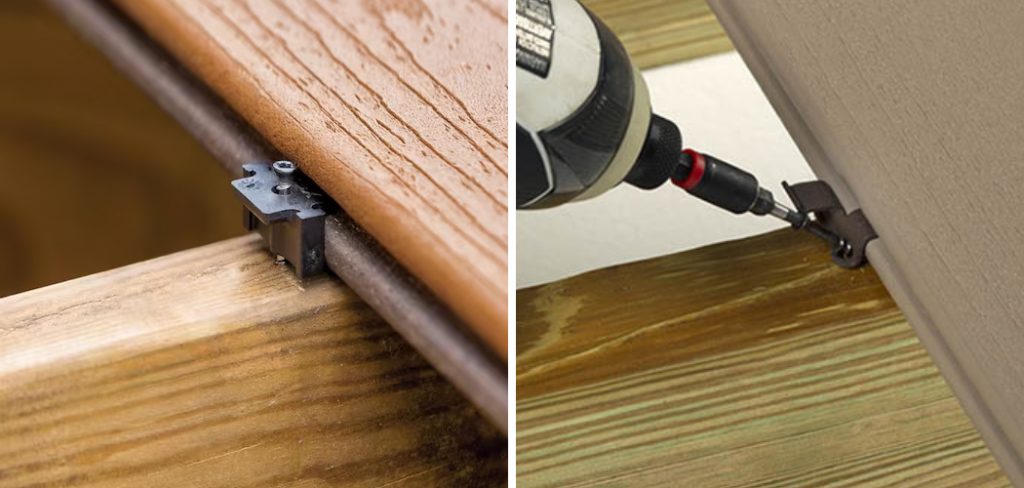
The quest for a flawless finish has led to the development of various innovative techniques. From hidden fastening systems that secure boards from below to the application of wood fillers or epoxy that render screws invisible, the methods are as diverse as they are effective. Face-screwing techniques and plug systems offer an equally durable yet aesthetically pleasing solution.
The benefits of achieving a seamless deck surface are manifold. Not only does it enhance the beauty and value of the structure, but it also creates a safer, more enjoyable outdoor living space. Without protruding screws, the risk of snags, cuts, or other injuries is significantly reduced, ensuring a smooth and welcoming surface for bare feet and hands alike.
Preparing the Deck Surface
The fundamental step in concealing deck screws begins with meticulous preparation of the deck surface. This phase lays the groundwork for a flawless finish, ensuring that the subsequent methods employed to hide screws are both effective and enduring.
A. Ensuring Proper Alignment and Installation of Deck Boards
Proper alignment of deck boards is crucial. Each board must be laid precisely, ensuring straight lines and uniform direction. This not only affects the aesthetic appeal but also the functional integrity of the deck. Employing tools such as straight edges or laser levelers can aid in achieving perfect alignment. Additionally, installing deck boards with care and avoiding any gaps or overlaps is vital for a seamless surface upon which the concealment techniques can be effectively applied.
B. Checking for Proper Spacing Between Boards
Spacing between boards is another critical aspect that requires attention. Adequate spacing allows for natural expansion and contraction of the wood, preventing warping and maintaining the deck’s structural integrity. Utilizing spacers during installation can guarantee consistent intervals between boards, facilitating drainage and airflow to keep the deck dry and long-lasting.
C. Cleaning and Preparing the Deck Surface for Concealment
Once alignment and spacing are addressed, the deck surface must be cleaned thoroughly. Removing debris, dust, and any form of contamination ensures that the concealment methods, such as fillers, stains, or fasteners, adhere properly and perform as intended.

Sanding the surface may also be necessary to remove rough spots and create a smooth base for the subsequent steps. This preparatory work is foundational, setting the stage for a deck that not only hides screws effectively but also stands the test of time in both function and beauty.
How to Hide Deck Screws: Using Concealed Fastening Systems
The mastery of concealing deck screws through hidden fastening systems is both an art and a science, heralding a new era in deck aesthetics and longevity. These systems cleverly secure deck boards without visible screws, maintaining the wood’s pristine appearance while enhancing structural integrity.
A. Exploring Hidden Fastener Clips or Systems
Hidden fastener systems represent the zenith of invisible decking solutions. Comprising various clips and fasteners designed to lock into the sides or undersides of decking boards, these systems offer a clean, screw-free surface. The appropriate system selection hinges on deck material and personal preference for the final appearance. Metal clips and plastic fasteners, each with unique benefits, provide a secure fit that allows for natural wood movement, ensuring the deck’s resilience over time.
B. Installing Hidden Fasteners According to Manufacturer Instructions
Adherence to the manufacturer’s installation instructions is paramount when using hidden fasteners. This meticulous process ensures that every board is securely attached, preserving the integrity of the deck structure. The installation typically involves precise positioning and angling of the fasteners, which often requires specialized tools provided by the manufacturer. By following these guidelines, builders can achieve a harmonious balance between aesthetic allure and enduring stability.
C. Ensuring Proper Spacing and Alignment of Hidden Fasteners
The strategic placement of hidden fasteners is critical for ensuring uniform spacing and alignment, hallmarks of a professionally installed deck. This impacts the deck’s durability and not only its visual appeal. Proper spacing facilitates water drainage and air circulation, preventing moisture entrapment that can lead to wood deterioration. Aligning fasteners symmetrically ensures an equal distribution of weight and stress across the deck, a testament to the principles of balance and harmony in construction.

Integrating concealed fastening systems into deck construction is a testament to the evolution of building techniques. By prioritizing both form and function, these systems embody the commitment to excellence that characterizes the timeless, harmonious approach to crafting spaces that are visually pleasing and built to last.
How to Hide Deck Screws: Using Face-Screwing Techniques
The application of face-screwing techniques juxtaposes the modernity of concealed fastenings with the age-old reliability of direct attachment. This method, while straightforward, calls for precision and a discerning eye to blend seamlessly with the deck’s surface, ensuring strength without compromising beauty.
A. Choosing Matching Deck Screws or Plugs
Selecting screws or plugs that harmonize with the decking material is fundamental. The aim is to achieve a look that is as unobtrusive as possible. Manufacturers offer screws and plugs in a variety of materials and finishes designed to match popular decking woods and composites. The choice of screws should not only consider the aesthetic aspect but also the durability and resistance to elements, ensuring the longevity of the deck structure.
B. Pre-Drilling Holes for Screws
Pre-drilling is an essential step that cannot be overlooked in the face-screwing technique. This preparatory action prevents the wood from splitting by accommodating the screw without undue stress on the material. The pre-drilled hole should be slightly narrower than the screw to retain the screw’s gripping power. This precision ensures that the screw secures tightly, maintaining the deck’s structural integrity and aesthetic harmony.
C. Countersinking Screws and Plugging Holes for a Flush Finish
The elegance of a deck can be significantly enhanced by countersinking screws and filling the holes with matching plugs for a flush finish. This method conceals the screws beneath the deck surface, maintaining a smooth and uniform appearance. Countersinking creates a recessed hole that allows the screw head to sit below the surface of the wood.

After driving the screw into the pre-drilled hole, a wood plug, cut from the same material as the decking or chosen to match, is glued and fitted into the hole. Once the glue dries, the plug can be sanded down to ensure it is perfectly flush with the deck surface, rendering the screw invisible and the deck surface impeccably smooth.
By marrying the functional necessity of screw fastening with the aesthetic desire for a seamless surface, face-screwing techniques with countersinking and plugging elevate the art of deck construction. This approach reflects a harmonious blend of tradition and innovation, allowing the beauty of the wood to take center stage while ensuring the structure’s resilience and longevity.
How to Hide Deck Screws: Using Wood Filler or Epoxy
In the quest for perfecting deck aesthetics and ensuring longevity, selecting and applying wood filler or epoxy to fill screw holes emerges as a pivotal technique. This method not only conceals the presence of screws but also prevents moisture ingress, safeguarding the wood against the elements.
A. Selecting Wood Filler or Epoxy Suitable for Outdoor Use
The selection of wood filler or epoxy demands discernment, for not all products are created equal. It is imperative to choose materials specifically formulated for outdoor use that are capable of withstanding the rigors of weather and temperature fluctuations. These products must also be compatible with your deck’s wood species, ensuring functional endurance and an aesthetic blend with the surrounding material.
B. Filling Screw Holes with Wood Filler or Epoxy
The meticulous application of wood filler or epoxy is a testament to the craftsman’s dedication to both function and form. Filling screw holes must be done with care, ensuring that the filler or epoxy is not merely applied but integrated into the wood. An error occurred during generation. Please try again or contact support if it continues.
Using Decorative Features to Conceal Screws
In the grand tapestry of deck construction, the true skill of a craftsman is not only in creating a functional space but also in ensuring every element harmonizes, creating a seamless aesthetic. Toward this end, utilizing decorative features to conceal screws presents an opportunity to blend practicality with elegance, ensuring that the deck’s surface remains unblemished by the mechanical elements of construction.
A. Incorporating Deck Skirting or Lattice to Hide Screws Along Edges
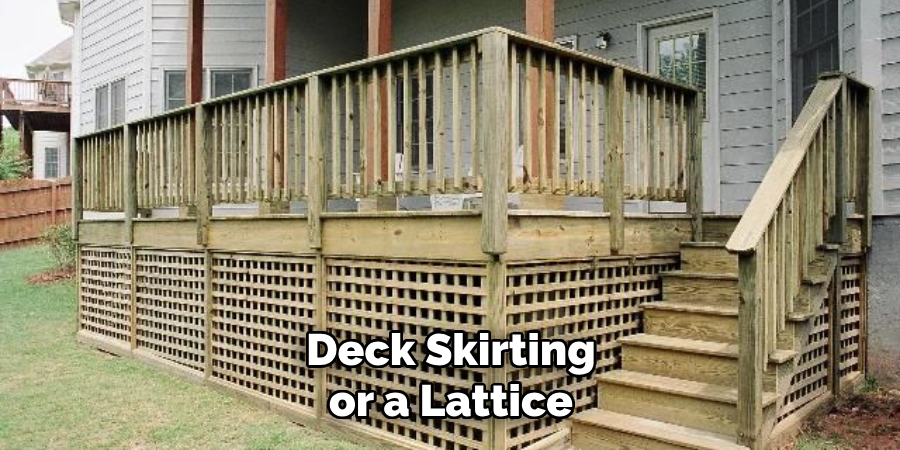
Deck skirting or a lattice, when thoughtfully incorporated, does more than just hide screws along the edges of a deck; it adds a layer of sophistication and charm. The strategic placement of these elements reinforces the deck’s structure while seamlessly integrating it with the landscape. By choosing materials and designs that complement the decking, skirting can be the perfect convergence between functionality and aesthetic appeal while keeping the utilitarian aspects discreetly out of sight.
B. Installing Decorative Trim or Molding Along Deck Perimeter
Decorative trim or molding provides an unmatched finish to the deck’s perimeter, hiding any screws and fasteners that secure the structure. This enhances the deck’s elegance and adds to its architectural integrity. Selecting trim or molding that resonates with the deck’s design theme ensures a cohesive look, transforming a simple boundary into an artful accent. This approach is a testament to the harmonious marriage of form and function, where even the smallest details contribute to the deck’s overarching beauty.
C. Adding Planters, Benches, or Built-In Seating to Cover Screw Locations
Finally, integrating planters, benches, or built-in seating not only serves the practical purpose of concealing screw locations but also enriches the deck’s usability and aesthetic value. Such additions invite nature closer, creating an enclave of tranquility and comfort. The precise positioning of these elements can artfully mask hardware while also providing a venue for relaxation and socialization. Here, utility and beauty intertwine, offering a serene retreat where none would suspect the behind-the-scenes intricacies of its construction.
In pursuit of perfection, these decorative techniques homage to the ageless artistry of deck building. They echo a harmonious symphony of innovation and tradition, where even the means of concealment contribute to the overarching masterpiece. This approach not only elevates the deck’s structural integrity but also preserves its surface’s timeless appeal, ensuring that the space remains a sanctuary of peace and beauty for years to come.
Experimenting with Staining or Painting
The narrative of deck augmentation through staining or painting is one rich with potential and creativity. This process protects the deck from the elements and offers an opportunity to enhance its aesthetic appeal, ensuring that it stands as a testament to timeless beauty and resilience.
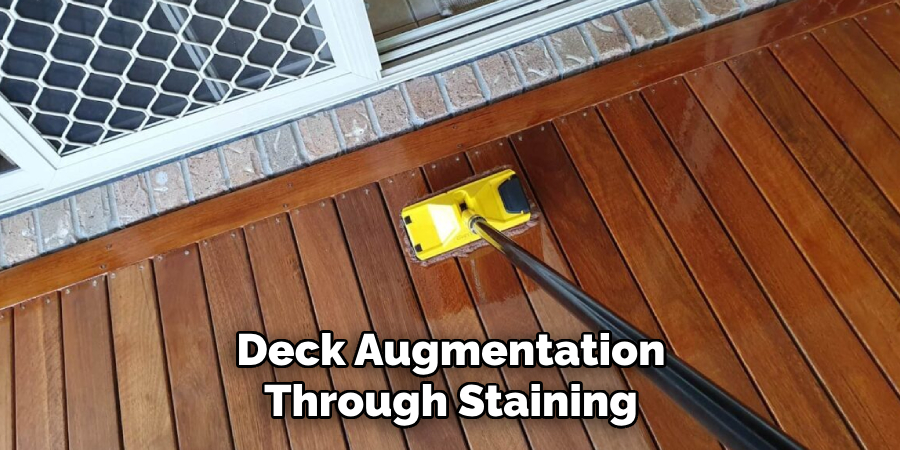
A. Choosing Stain or Paint Colors to Match Decking
In the realm of deck construction, selecting the perfect stain or paint color to match the decking material is an exercise in finesse and harmony. It requires a keen eye for color balance and understanding how hues interact with natural light and the surrounding environment.
The ideal choice complements the deck’s primary tone, enriching its natural beauty without overshadowing it. This careful selection process ensures that the deck remains a cohesive element of the outdoor space, echoing its theme and enhancing its overall ambiance.
B. Staining or Painting Screw Heads to Blend with Deck Surface
Attention to detail is paramount in the exquisite art of deck finishing. Staining or painting screw heads to blend with the deck surface exemplifies the meticulous nature of creating a harmonious outdoor space. This process involves matching the color of the screws with the deck’s finish, ensuring they become virtually invisible to the observer. Achieving such a seamless integration requires precision and a delicate touch, underscoring the deck’s elegance and the craftsman’s commitment to excellence.
C. Applying Multiple Coats for Durability and Longevity
The durability and longevity of a deck’s finish are foundational to its legacy. Applying multiple coats of stain or paint is not merely a protective measure but an assurance of its enduring beauty. Each layer contributes to a robust barrier against wear, weather, and time, encapsulating the deck in an armor of resilience.

This methodical approach ensures that the deck can withstand the elements and the passage of time, preserving its aesthetic appeal and structural integrity. With every additional coat, the deck’s resistance to the adversities of nature is fortified, promising a future where its beauty remains undiminished by the years.
In the grand narrative of deck construction, experimenting with staining or painting emerges as a pivotal chapter. It is a testament to the builder’s prowess, a blend of practical skill and artistic vision. Here, the deck transcends its functional role, becoming a canvas upon which the timelessness of beauty and the promise of durability are etched.
Post-Installation Maintenance
Once integrated into the domain, a deck’s stewardship extends beyond its initial construction and aesthetic enhancements. Its enduring commitment to its preservation and functionality ensures its legacy through the ages.
A. Regularly Inspecting Deck Surface for Loose or Exposed Screws
Vigilance in the routine inspection of the deck surface for any protruding or mislaid screws is paramount. This critical step not only safeguards the structure’s integrity but also preserves the seamless beauty of its façade. Such scrutiny, performed with meticulous care, allows for the timely identification and rectification of minor issues before they can escalate, ensuring the deck remains a bastion of safety and elegance.
B. Reapplying Wood Filler or Epoxy as Needed
Continuity in the deck’s visual and structural coherence may necessitate the reapplication of wood filler or epoxy to areas where time and the elements have left their mark. This act of renewal, steeped in the artistry and wisdom of maintenance, serves to mend the scars of wear, sealing them with a promise of revitalization. Through this thoughtful intervention, the deck continues to present an unblemished surface to the world, a reflection of enduring care.
C. Performing Periodic Checks and Touch-Ups for a Seamless Finish
The commitment to maintaining a deck’s pristine condition culminates in the execution of periodic checks and the precision of touch-ups. These acts, though seemingly minor, are pivotal in sustaining the deck’s initial grandeur.
Attention to fading areas, the integrity of the stain or paint, and the subtle signs of aging allow for timely rejuvenation. By addressing these with a skilled hand and an eye for detail, the deck retains its seamless finish, standing as a testament to the harmonious unity of form and function, resilient against the passage of time.
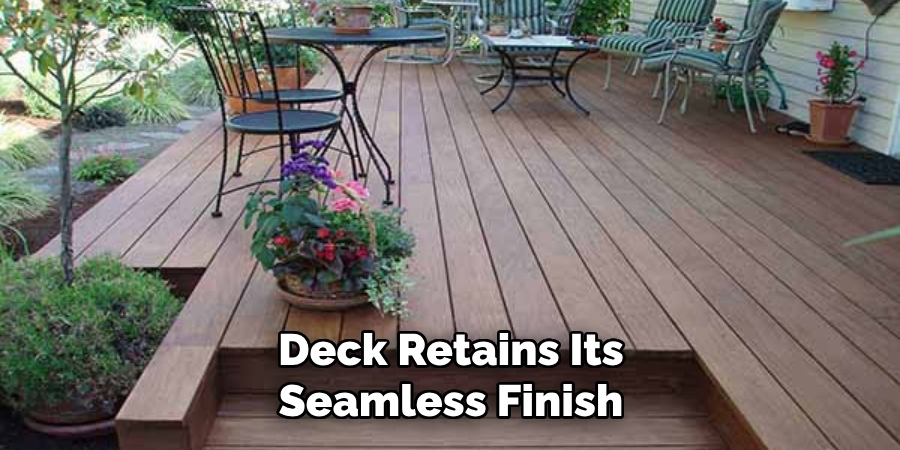
Through these pillars of post-installation maintenance, the deck’s saga continues, an enduring narrative of beauty and diligence. Such is the pathway to preserving its physical integrity and soul, ensuring it remains a sanctum of peace, beauty, and timeless elegance for generations to cherish.
Safety Considerations
The narrative of constructing a sanctuary such as a deck is incomplete without underscoring the paramount importance of safety. It stands as a pillar, ensuring the well-being of those who bring the vision into reality and those who will enjoy its splendor.
A. Using Proper Tools and Equipment for Screw Concealment
In the meticulous process of screw concealment, the employment of proper tools and equipment is not merely a recommendation; it is an imperative. This ensures not only the precision of the task at hand but, more importantly, the safety of the artisan. Utilizing the right tools minimizes the risk of accidents, safeguarding the individuals involved in crafting the deck’s beauty from potential harm.
B. Following Manufacturer Instructions for Fasteners and Fillers
The wisdom imparted through the manufacturer’s instructions for using fasteners and fillers is a beacon of safety in the construction odyssey. Adherence to these guidelines ensures that the materials are used to their full efficacy and integrity, preventing structural failings that could compromise safety. It is a testament to the harmonious relationship between following sage advice and achieving a reliable and secure construction.
C. Taking Precautions to Avoid Injury During Installation
The act of installation, while a testament to human ingenuity and creativity, is fraught with challenges that, if underestimated, can lead to injury. It is incumbent upon the builders to don appropriate protective gear, conduct themselves with awareness, and engage in practices that prioritize their safety and that of their cohorts.
This includes being vigilant about the workspace, respecting tools, and taking necessary breaks to prevent fatigue. Each precaution taken is a step towards ensuring that the deck emerges not only as a triumph of aesthetics and functionality but also as a monument to the safety and well-being of its creators.
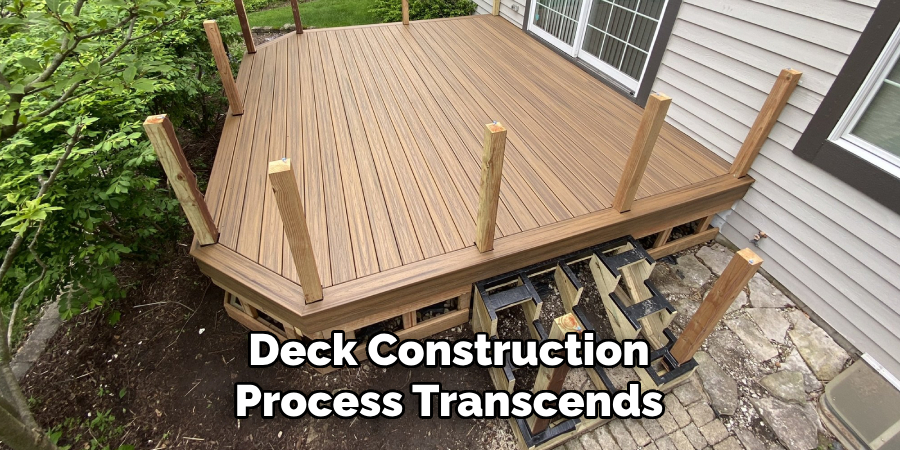
Through careful attention to these safety considerations, the deck construction process transcends its physical dimensions, embodying a conscientious approach that honors the well-being of all involved. This commitment to safety is a fundamental component of the legacy of any deck, ensuring it can be enjoyed with peace of mind, nestled in its timeless elegance and resilience.
Conclusion
Our exploration illuminated various strategies for concealing deck screws, ranging from the use of countersinking and filling methods to the innovative adoption of hidden fastening systems. Each method, with its unique merits, contributes to the overarching aim of preserving the deck’s visual harmony and tactile smoothness.
The quest for a seamless deck surface is not merely an exercise in aesthetics; it is a pursuit of harmony, a reflection of nature’s flawless continuum. A deck devoid of visible screws or fasteners stands as a testament to the craftsman’s skill, inviting unbroken communion with the natural world.
In mastering how to hide deck screws, artisans are encouraged to consider not only the immediate visual and structural outcomes but the long-term integrity of the deck. Employing quality materials, selecting the appropriate concealment method for your specific deck material, and engaging with the task with patience and precision are crucial.
A meticulous approach, coupled with a steadfast commitment to excellence, ensures the enduring beauty and utility of the deck. Thus, our narrative comes full circle, reaffirming the enduring principles of craftsmanship that guide the creation of truly timeless structures.
About the Author
Adrian Green, a lifelong woodworking enthusiast, shares his passion for the craft through The Woodenify Blog. With a foundation built on years of hands-on experience in his father’s woodworking shop, Adrian is dedicated to helping others learn and grow in the world of DIY woodworking. His approach to woodworking combines creativity, practicality, and a deep appreciation for the art of building with your own hands. Through his blog, he inspires individuals of all skill levels to embark on their own woodworking journeys, creating beautiful, functional pieces of furniture and décor.
Professional Focus
- Specializes in DIY woodworking projects, from furniture to home décor.
- Provides step-by-step guides and practical tutorials for woodworkers of all skill levels.
- Dedicated to helping readers build confidence and skill through easy-to-follow instructions and tips.
- Passionate about fostering a community of makers who can share, learn, and grow together.
Education History
- University of Craft and Design – Bachelor of Fine Arts (BFA) in Woodworking and Furniture Design
- Woodworking Apprenticeships – Extensive hands-on training with skilled craftsmen to refine carpentry and furniture making techniques.
- Online Courses & Masterclasses – Continued education in advanced woodworking techniques, design principles, and specialized tools
Expertise:
- DIY woodworking, carpentry, furniture making, and home décor projects.
- Creating accessible tutorials and guides for beginner to advanced woodworkers.
- Sharing the joys and satisfaction of woodworking, from raw materials to finished products.
